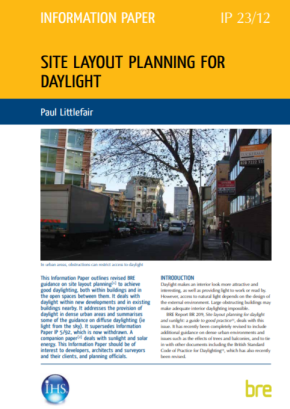Site layout planning for daylight IP 23 12
Site layout planning for daylight (IP 23/12) was written by Paul Littlefair and published by BRE on 16 October 2012. It superseded IP5/92 which was withdrawn.
Daylight makes an interior look more attractive and interesting, as well as providing light to work or read by. However, access to natural light depends on the design of the external environment. Large obstructing buildings may make adequate interior daylighting impossible
This 6-page Information Paper outlines revised BRE guidance on site layout planning to achieve good daylighting, both within buildings and in the open spaces between them. It deals with daylight within new developments and in existing buildings nearby. It addresses the provision of daylight in dense urban areas and summarises some of the guidance on diffuse daylighting (ie light from the sky rather than direct from the sun).
This Information Paper should be of interest to developers, architects, surveyors, clients, and planning officials.
Its contents are:
- Introduction.
- Daylight within a new development.
- Existing buildings.
- Trees and hedges.
- Conclusions.
- References.
It is available at: https://www.brebookshop.com/details.jsp?id=327076
See also: Site layout planning for daylight and sunlight.
[edit] Related articles on Designing Buildings Wiki
- 7 ways better lighting can improve your health.
- BRE articles on Designing Buildings Wiki.
- BRE Expert Collection 6 Daylight and shading.
- Building Research Establishment.
- EN 17037 Daylight in buildings.
- Health and wellbeing impacts of natural and artificial lighting.
- Light obstruction notice.
- Light pollution.
- Lighting and energy efficiency.
- Lighting and health infographic.
- Lighting of construction sites.
- Natural light.
- Passive building design.
- Right to light.
- Site layout planning for daylight and sunlight.
- Solar gain in buildings.
- Use of lighting to improve health and wellbeing.
Featured articles and news
RTPI leader to become new CIOB Chief Executive Officer
Dr Victoria Hills MRTPI, FICE to take over after Caroline Gumble’s departure.
Social and affordable housing, a long term plan for delivery
The “Delivering a Decade of Renewal for Social and Affordable Housing” strategy sets out future path.
A change to adoptive architecture
Effects of global weather warming on architectural detailing, material choice and human interaction.
The proposed publicly owned and backed subsidiary of Homes England, to facilitate new homes.
How big is the problem and what can we do to mitigate the effects?
Overheating guidance and tools for building designers
A number of cool guides to help with the heat.
The UK's Modern Industrial Strategy: A 10 year plan
Previous consultation criticism, current key elements and general support with some persisting reservations.
Building Safety Regulator reforms
New roles, new staff and a new fast track service pave the way for a single construction regulator.
Architectural Technologist CPDs and Communications
CIAT CPD… and how you can do it!
Cooling centres and cool spaces
Managing extreme heat in cities by directing the public to places for heat stress relief and water sources.
Winter gardens: A brief history and warm variations
Extending the season with glass in different forms and terms.
Restoring Great Yarmouth's Winter Gardens
Transforming one of the least sustainable constructions imaginable.
Construction Skills Mission Board launch sector drive
Newly formed government and industry collaboration set strategy for recruiting an additional 100,000 construction workers a year.
New Architects Code comes into effect in September 2025
ARB Architects Code of Conduct and Practice available with ongoing consultation regarding guidance.
Welsh Skills Body (Medr) launches ambitious plan
The new skills body brings together funding and regulation of tertiary education and research for the devolved nation.
Paul Gandy FCIOB announced as next CIOB President
Former Tilbury Douglas CEO takes helm.
UK Infrastructure: A 10 Year Strategy. In brief with reactions
With the National Infrastructure and Service Transformation Authority (NISTA).
























